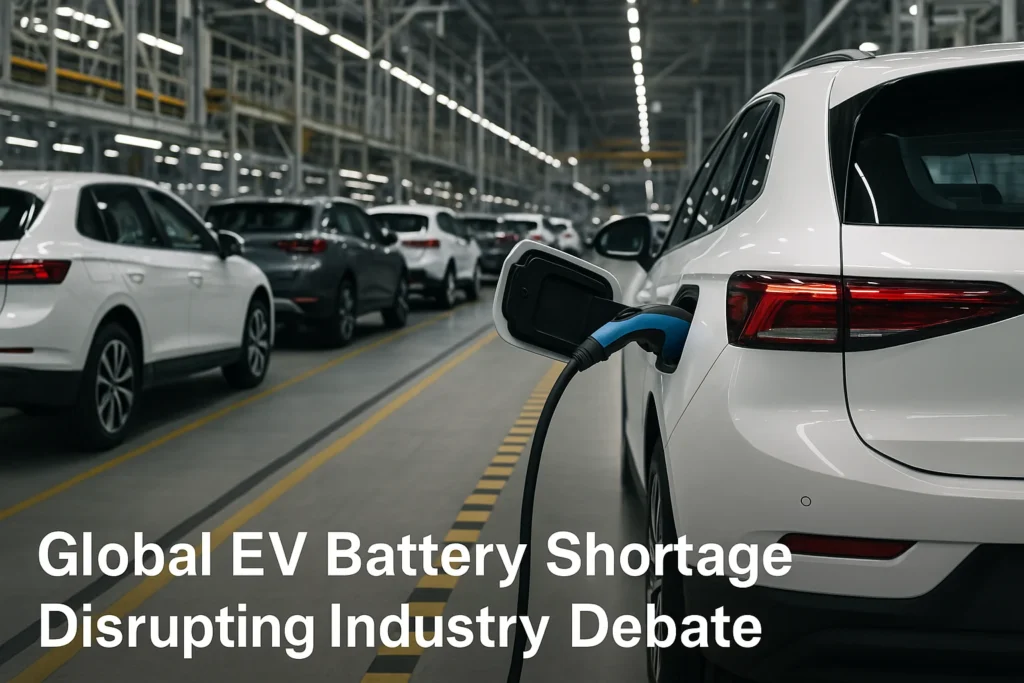Introduction: The Electric Dream Meets a Hard Reality
For years, the future of transportation has glittered with the promise of electric vehicles (EVs). Silent, swift, and seemingly clean, EVs were hailed as the solution to climate change and reliance on fossil fuels. In the early months of 2025, that dream seemed closer than ever, with EV sales hitting record highs globally. From bustling city streets to quiet suburban roads, more electric cars were being sold than ever before, signaling a clear shift in how we move.
But every dream has its challenges, and for the auto industry, the soaring success of EVs has unearthed a critical vulnerability: a severe shortage of the very heart of these vehicles – lithium-ion batteries. Suddenly, the smooth hum of progress is replaced by the creak of paused production lines. Major car manufacturers, once brimming with confidence, are now scrambling. Governments are stepping in, realizing that national economic strength and environmental goals are tied to securing these vital power packs. The world is quickly learning that going electric isn’t just about making cars; it’s about mastering the complex, global journey of the battery.
The Unprecedented Surge: A Global Thirst for EVs
The first half of 2025 has been nothing short of a boom for electric vehicles. Across continents, drivers embraced EVs with unprecedented enthusiasm, pushing sales numbers to dizzying heights. This wasn’t just a slight increase; it was a powerful wave.
The Numbers Tell the Story
- Explosive Growth: In the first three months of 2025 alone, the global sales of battery-electric vehicles (BEVs) and plug-in hybrids (PHEVs) combined reached a staggering 4.3 million units. This represented a colossal 34.9% year-on-year growth compared to the same period in 2024. The demand for all-electric cars (BEVs) specifically surged, accounting for 63.7% of all EV sales.
- Battery Demand Soars: This consumer enthusiasm translated directly into an immense appetite for batteries. From January to April 2025, the total usage of EV batteries worldwide hit 308.5 Gigawatt-hours (GWh), marking a remarkable 40.2% year-over-year increase. This shows that the production and installation of batteries simply couldn’t keep pace with the number of EVs rolling off assembly lines.
This rapid adoption, while a triumph for climate goals, has exposed a raw nerve in the global supply chain. The infrastructure and raw material extraction needed to power this electric revolution simply weren’t ready for such a sudden and massive surge. The demand curve rocketed skyward, leaving the supply lines struggling to catch up.
Auto Giants Hit the Brakes: Production Slowdowns Emerge
The ripple effect of the battery shortage is now causing widespread disruption across the auto industry. What started as whispers of supply chain issues in late 2024 has grown into a significant challenge, forcing some of the world’s largest automakers to make difficult decisions.
From Assembly Lines to Boardrooms
Automakers, once fiercely competing for EV market share, are now contending with a shared headache: not enough batteries. This has led to noticeable impacts on their production schedules:
- Volkswagen’s Strategic Shift: Volkswagen, a major player in the European EV market, has experienced a complex journey. While their BEV deliveries in Europe actually doubled in the first quarter of 2025, pointing to strong consumer demand, the company had already begun adjusting its broader EV strategy. In late 2024, anticipating or reacting to supply chain pressures, VW had already cut some EV production and even abandoned plans for a new EV plant in Germany. This proactive, albeit painful, move highlighted their awareness of potential battery constraints. They are now investing heavily in securing battery supply chains to prevent future bottlenecks, a clear sign that battery access dictates their manufacturing pace.
- Tesla’s Evolving Challenges: Tesla, long the undisputed leader in EVs, has also faced a complex year. While their challenges extend beyond just battery supply – including intense competition, a softening demand in certain markets, and even political distractions – the broader environment of constrained battery components contributes to the industry’s overall tightness. Tesla, while a major battery consumer, is also vertically integrated, meaning they produce some of their own batteries. However, even for a company with such internal capabilities, a global shortage impacts the wider availability and pricing of critical materials, indirectly affecting their production scalability and ability to meet demand.
- Hyundai’s Proactive Measures: Hyundai, recognizing the long-term strategic importance of battery independence, has taken significant steps. While specific announcements about temporary slowdowns due to battery constraints in early 2025 for Hyundai were not explicitly detailed, their aggressive investment in developing their own solid-state batteries (aiming for trial production by late 2025) and inaugurating new battery assembly plants reflects a clear strategic move to control their destiny in a constrained market. This forward-looking approach indicates a clear understanding that a stable, in-house battery supply is crucial to avoid future disruptions.
- BYD’s Integrated Advantage: Interestingly, China’s BYD stands out. As the world’s second-largest EV battery manufacturer and a major EV producer, BYD has a significant advantage due to its in-house battery production. Their battery installations saw a massive 60.8% growth in early 2025. While other manufacturers grapple with external supply, BYD’s integrated model helps them maintain strong production levels, making them a less likely candidate for slowdowns caused by external battery shortages. Their success highlights the strategic benefit of controlling the battery supply chain.
For many automakers, the message is clear: if you can’t secure batteries, you can’t build EVs, regardless of how high demand might be. The shortage isn’t just slowing down production; it’s forcing a fundamental rethinking of global manufacturing strategies.
The Earth’s Hidden Treasures: A Mineral Bottleneck
At the heart of every lithium-ion battery are specific minerals: lithium, nickel, and cobalt. These are not simply dug out of the ground in any quantity. Extracting, processing, and refining them to “battery-grade” quality is a complex, time-consuming, and resource-intensive process. As EV demand skyrocketed, the supply of these critical raw materials simply couldn’t keep up.
The Scarce Ingredients
- Lithium’s Importance: Lithium is the namesake element of these batteries, crucial for their energy storage capabilities. While global lithium supply grew in 2024, the pace of investment in new mining projects and processing facilities has weakened. This means that while some lithium is available, the pipeline for future supply to meet ever-increasing demand is not as robust as it needs to be.
- Nickel’s Role: Nickel is vital for increasing battery energy density, allowing EVs to travel further on a single charge. Like lithium, its supply chain faces challenges, particularly in refining and processing. The global supply of refined nickel has become increasingly concentrated in just a few countries, making the entire supply chain more vulnerable to disruptions.
- Cobalt’s Dilemma: Cobalt, while a smaller component by weight, is critical for battery stability and longevity. The supply of battery-grade cobalt is also highly concentrated, with a significant portion coming from a single region. This concentration, combined with underinvestment in new projects, contributes to its scarcity as demand for EVs accelerates.
Even if prices for these minerals saw a dip in 2024 due to temporary oversupply or market speculation, the underlying reality for 2025 is that the rate of extraction and refining is not matching the skyrocketing demand from EV manufacturers. It’s like trying to fill a swimming pool with a garden hose – no matter how much water is in the reservoir, the flow rate limits how quickly the pool can be filled. The bottleneck isn’t always the raw material itself, but the industrial capacity to turn it into a usable form for batteries.
The Race for Innovation: Beyond Lithium-Ion
The current battery shortage and reliance on limited raw materials have injected a new urgency into the search for alternative battery technologies. Scientists and engineers are working around the clock to develop solutions that are cheaper, safer, and more abundant, promising a future less dependent on the current lithium-ion chemistry.
Powering Tomorrow’s EVs
- Sodium-Ion Batteries: One of the most promising alternatives is the sodium-ion battery. Sodium is far more abundant and cheaper than lithium, making these batteries a game-changer for affordability and supply chain stability. Chinese battery giant CATL plans to start mass-producing its sodium-ion batteries, called Naxtra, by December 2025. These batteries are designed to offer comparable performance for urban EVs, with decent ranges and excellent cold-weather performance. This technology could significantly reduce the industry’s reliance on specific, geographically limited resources, paving the way for “energy freedom.”
- Solid-State Batteries: Often called the “holy grail” of battery technology, solid-state batteries use a solid electrolyte instead of the liquid one found in traditional lithium-ion batteries. This makes them potentially safer (less prone to fire), allows for higher energy density (longer range), and faster charging. Companies like QuantumScape and Solid Power are making significant strides with pilot production lines. Major automakers are heavily invested: Toyota is aiming for a solid-state EV by 2027, and Hyundai plans to trial-produce EVs equipped with solid-state batteries by the end of 2025. While mass production is still a few years away for most, the progress is rapid.
- Battery Recycling: Beyond new chemistries, battery recycling is becoming a critical part of the solution. Instead of discarding used EV batteries, advanced recycling technologies can recover valuable materials like lithium, nickel, and cobalt. Companies like Redwood Materials in North America are already recycling over 70% of lithium-ion batteries on the continent and recovering nearly all important minerals (98%). This “closed-loop” system reduces the need for new mining, lessens environmental impact, and creates a more sustainable and circular economy for EVs. Efforts are being made globally, with events like E-TECH EUROPE 2025 focusing on comprehensive battery recycling solutions and the “second life” of EV batteries for energy storage.
These technological advancements are not just about finding substitutes; they are about building a more resilient, sustainable, and diversified future for electric mobility, ensuring that the dream of widespread EV adoption isn’t hampered by material scarcity.
Geopolitical Chess: Securing Domestic Supply Chains
The battery shortage has underscored a critical national security issue: many countries’ reliance on a handful of nations, particularly China, for vital battery components and refined minerals. This has triggered a geopolitical scramble, with major economic blocs like the U.S. and the EU pouring massive investments into building their own domestic battery production capabilities.
A Quest for Battery Independence
- U.S. Takes Action: The United States is aggressively working to reduce its dependence on foreign battery supply chains, especially those concentrated in China. In April 2025, the U.S. energy storage industry committed a historic $100 billion investment into building and buying American-made grid batteries by 2030. This includes significant capital for new manufacturing facilities and procurement of domestically produced batteries. Companies like LG Energy Solution are expanding U.S. production lines, with operations starting in Michigan in 2025. Tesla is also investing in refining capabilities in the U.S., and new battery companies like Form Energy are aiming to source over 80% of their materials domestically, even targeting U.S. mines for raw iron. The goal is clear: enhance energy security, boost domestic jobs, and ensure a reliable supply of batteries for EVs and grid storage.
- EU’s Strategic Autonomy: The European Union shares similar ambitions, driven by its Green Deal targets and a desire for strategic autonomy. The EU has implemented its own battery regulations, such as the Battery Regulation Directive, aimed at securing a sustainable and circular battery supply chain within Europe. They are heavily investing in establishing “gigafactories” – large-scale battery manufacturing plants – across the continent and fostering partnerships to secure alternative, sustainable sources of critical minerals. While challenges like high production costs and intense global competition remain, the EU’s commitment to reducing reliance on Chinese battery technologies and materials is unwavering.
This global shift isn’t just about manufacturing; it’s about control. Nations are realizing that controlling the entire battery supply chain, from mining to manufacturing to recycling, is essential for economic stability and future technological leadership in the electric age.
The Darker Side of the Boom: Environmental and Labor Concerns
While the electric vehicle revolution promises cleaner air and a greener future, the journey to create EV batteries begins deep underground, in mining operations that often carry a heavy cost. The surge in demand for critical battery minerals has intensified existing environmental damage and raised serious labor concerns, particularly in parts of Africa and South America.
The Human and Environmental Price
- Cobalt Mining in Africa: The Democratic Republic of Congo (DRC) in Central Africa supplies a significant portion of the world’s cobalt. The desperate need for this mineral often leads to tragic consequences. Reports from early 2025 continue to highlight severe labor concerns, including:
- Child Labor: An estimated 40,000 child miners, some as young as seven years old, work in dangerous conditions in DRC’s cobalt mines, often earning meager wages (as little as $2.50 a day).
- Unsafe Conditions: Adult miners also face unfair wages, lack protective gear, and are exposed to toxic dust, chemicals, and the constant risk of tunnel collapses.
- Community Displacement: The expansion of mines often leads to the forced displacement of local communities, leaving them without adequate housing or compensation.
- Sexual Assault Risks: Mines located in conflict zones disproportionately expose women and children to the risk of sexual assault.
- Environmental Degradation in Africa: The environmental impact in the DRC is equally stark. Toxic dumping near mines contaminates water sources and the environment, leading to high concentrations of cobalt in the soil that harm crops and human health. Air pollution and poor sanitation also contribute to respiratory illnesses and the spread of diseases in mining communities.
- Lithium Mining in South America: In the “lithium triangle” of Argentina, Bolivia, and Chile, which holds nearly 60% of the world’s lithium, extraction methods are raising significant environmental concerns:
- Water Depletion: The dominant evaporation-based extraction method for lithium consumes vast amounts of water. In Chile’s Atacama region, lithium mining has led to a shocking 30% reduction in groundwater levels, impacting delicate desert ecosystems, local vegetation, and even flamingo populations.
- Impact on Indigenous Communities: These environmental pressures directly threaten the livelihoods and cultural practices of Indigenous communities, who often lack meaningful participation in decision-making processes regarding the mining operations on their ancestral lands. Legal challenges are mounting, citing ecological harm and the lack of “free, prior, and informed consent” from these communities.
The pursuit of a “green” future with EVs must not come at the expense of human rights or the environment in the regions where these critical materials are sourced. Ensuring ethical sourcing and sustainable mining practices is a monumental challenge that the global auto industry and governments are only just beginning to truly address.
Conclusion: Powering Ahead, Responsibly
The “Global EV Battery Shortage” in early 2025 is a stark reminder that even the most promising technological revolutions come with complex challenges. While global EV demand grew over 40%, a staggering success, it has inadvertently revealed the fragile underbelly of the lithium-ion battery supply chain. Major automakers like Tesla, Hyundai, BYD, and VW have experienced direct or indirect impacts, with some announcing temporary slowdowns due to battery constraints, while others like BYD have thrived due to integrated supply.
The scarcity of battery-grade lithium, nickel, and cobalt has ignited a worldwide race to secure these vital minerals. This urgency is simultaneously fueling a powerful push toward new, more sustainable technologies like sodium-ion and solid-state batteries, and a critical emphasis on battery recycling. Geopolitically, the U.S. and EU are increasing investment in domestic battery production to reduce reliance on China, signaling a long-term shift in global industrial strategy. Yet, as the world scrambles for resources, we cannot ignore the pressing environmental and labor concerns surrounding mining operations in Africa and South America, demanding a moral reckoning alongside technological advancement.
The auto industry is not merely facing a temporary hiccup; it’s undergoing a fundamental restructuring. The journey to a fully electric future requires not just innovative engineering, but also robust, ethical, and diversified supply chains. The current battery shortage serves as a powerful call to action, urging the world to build a sustainable electric ecosystem that truly benefits everyone, from the mines to the road.



